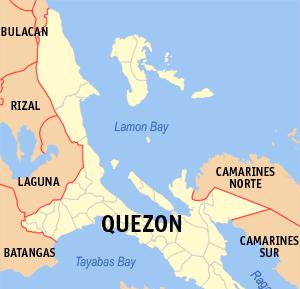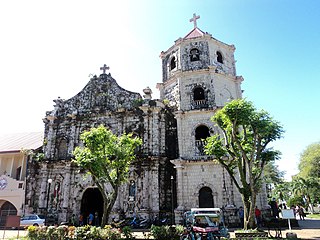Background
In 2007, Quezon was proposed to be split into Quezon del Norte and Quezon del Sur. Quezon del Norte was to be composed of the first and second congressional districts of the province (Burdeos, General Nakar, Infanta, Jomalig, Lucban, Mauban, Pagbilao, Panukulan, Patnanungan, Polillo, Real, Sampaloc, Tayabas, Candelaria, Dolores, San Antonio, Sariaya, Tiaong and Lucena City), with Lucena City as its capital. Quezon del Sur, with its capital at Gumaca, would have been composed of the third and fourth congressional districts (Agdangan, Buenavista, Catanauan, General Luna, Macalelon, Mulanay, Padre Burgos, Pitogo, San Andres, San Francisco, San Narciso, Unisan, Alabat, Atimonan, Calauag, Guinayangan, Gumaca, Lopez, Perez, Plaridel, Quezon and Tagkawayan). Republic Act No. 9495, the law stipulating the division, lapsed into law without the signature of President Gloria Macapagal Arroyo on September 7, 2007.
As required by law, the COMELEC held a plebiscite on December 13, 2008, 60 days after Republic Act No. 9495 took effect. Governor Rafael Nantes, one of the original authors of the law, and Vice Governor Kelly Portes opposed the division of the province. Quezon Provincial Board member Sonny Pulgar and businessman Hobart Dator Jr. launched the "Save Quezon Province Movement." The Comelec allotted ₱50 million for the plebiscite. [2] Academician Prof. Joseph Jadway "JJ" Marasigan provided what he called the "strong theoretical framework" that deemed the said split as a step backward. He instead called for the professionalization of service institutions and the differentiation of functions as the answer to the province's increasingly becoming complex environment. He organized students and fellow academicians to oppose such move. His participation resulted in a grave misunderstanding with Lucena Catholic Bishop Emilio Marquez who strongly supported the idea of splitting the province. Marasigan maintained that bishops have no business in dealing with entirely political matters and should refrain from using their influence over their flock. Nantes later softened his stand against the proposed creation of Quezon del Sur. [3] Accordingly, upon request of Comelec Chair Jose Melo, a ₱38 million "Special Allotment Release Order" was issued by the Department of Budget and Management to the Commission on Elections (Philippines) to fund the holding of the plebiscite. [4]
On November 17, 2008, Save Quezon Province Movement (SQPM) asked the Supreme Court of the Philippines to declare Republic Act No. 9495 as unconstitutional, and to restrain the implementation of a November 12 COMELEC Resolutions Nos. 8533, 8534, 8535, 8537, 8538 and 8539, [5] setting the plebiscite. [6] [7] Yet the plebiscite proceeded with the majority of votes rejecting the division, therefore the split did not push through.

Agdangan, officially the Municipality of Agdangan, is a 5th class municipality in the province of Quezon, Philippines. According to the 2020 census, it has a population of 12,764 people.

Burdeos, officially the Municipality of Burdeos, is a 4th class municipality in the province of Quezon, Philippines. According to the 2020 census, it has a population of 24,644 people.

Guinayangan, officially the Municipality of Guinayangan, is a 3rd class municipality in the province of Quezon, Philippines. According to the 2020 census, it has a population of 44,045 people.

Tagkawayan, officially the Municipality of Tagkawayan, is a 1st class municipality in the province of Quezon, Philippines. According to the 2020 census, it has a population of 54,003 people.

Unisan, officially the Municipality of Unisan, is a 4th class municipality in the province of Quezon, Philippines. According to the 2020 census, it has a population of 25,448 people.

The Pan-Philippine Highway, also known as the Maharlika Highway, is a network of roads, expressways, bridges, and ferry services that connect the islands of Luzon, Samar, Leyte, and Mindanao in the Philippines, serving as the country's principal transport backbone. Measuring 3,379.73 kilometers (2,100.07 mi) long excluding sea routes not counted by highway milestones, it is the longest road in the Philippines that forms the country's north–south backbone component of National Route 1 (N1) of the Philippine highway network. The entire highway is designated as Asian Highway 26 (AH26) of the Asian Highway Network.

Lamon Bay is a large bay in the southern part of Luzon island in the Philippines. It is a body of water connecting the southern part of Quezon province to the Philippine Sea, a marginal sea of the Pacific Ocean. It borders on the coastal towns of Atimonan, Gumaca, Plaridel, Lopez, Calauag, and the islands of Alabat.

The Roman Catholic Diocese of Lucena is a diocese of the Roman Catholic Church in the Philippines with the seat in Lucena City. The Roman Rite Latin Church diocese was erected in 1950 from the Archdiocese of Lipa to become a suffragan diocese of the archdiocese. In 1977, the Diocese of Boac, which covers the parishes in the island-province of Marinduque, was created and separated from Lucena. In 1984, the Diocese of Lucena was further divided with the creation of the Diocese of Gumaca, which covers the municipalities of Quezon province east of Gumaca, Quezon.

The Roman Catholic Diocese of Gumaca is a Roman Catholic diocese in the Philippines centered in the Municipality of Gumaca in Quezon province. The Roman Rite Latin Church diocese covers the communities of Gumaca; Pitogo, due south of Gumaca; and all the parishes of eastern Quezon province situated east of Gumaca and Pitogo. The Gumaca diocese was erected in 1984, carved out from the Diocese of Lucena. Both dioceses are suffragan of the Archdiocese of Lipa.

Quezon, officially the Province of Quezon, is a province in the Philippines located in the Calabarzon region on Luzon. Kalilayan was the first known name of the province upon its creation in 1591. Around the middle of the 18th century, it was changed to Tayabas. In 1946, in recognition of the second president of the Philippines, Manuel L. Quezon, the name of Tayabas Province was changed to Quezon. Lucena, the provincial capital, the seat of the provincial government, and the most populous city of the province, is governed independently from the province as a highly urbanized city. To distinguish the province from Quezon City, it is sometimes called Quezon Province, a variation of the province's official name.

Rolando Andaya Highway, officially known as Quirino Highway and also known as Camarines Sur–Quezon Road, is a national primary highway located in the provinces of Camarines Norte, Quezon, and Camarines Sur in the Philippines. It serves as an alternative route to the Pan-Philippine Highway and has been efficiently used as a major highway since the 1990s. It traverses the municipality of Santa Elena in Camarines Norte, municipalities of Sipocot, Lupi, Ragay, and Del Gallego in Camarines Sur, and the municipalities of Tagkawayan, Guinayangan, and Calauag in Quezon. It is primarily known as Andaya Highway in segments within Camarines Sur and likewise called as Quirino Highway within Camarines Norte and Quezon.
Local elections were held in the province of Quezon on May 13, 2013, as part of the 2013 general election. Voters will select candidates for all local positions: a town mayor, vice mayor and town councilors, as well as members of the Sangguniang Panlalawigan, the vice-governor, governor and representatives for the four districts of Quezon.

National Route 1 (N1) is a primary national route that forms part of the Philippine highway network, running from Luzon to Mindanao. Except for a 19-kilometer (12 mi) gap in Metro Manila and ferry connections, the highway is generally continuous. Most sections of N1 forms the Pan-Philippine Highway except for sections bypassed by expressways.

Local elections were held in the Province of Quezon on May 13, 2019 as part of the 2019 general election. Voters selected candidates for all local positions: a town mayor, vice mayor and town councilors, as well as members of the Sangguniang Panlalawigan, the vice-governor, governor and representatives for the four districts of Quezon.

Quezon's 1st congressional district is one of the four congressional districts of the Philippines in the province of Quezon, formerly Tayabas. It has been represented in the House of Representatives of the Philippines since 1916 and earlier in the Philippine Assembly from 1907 to 1916. The district consists of the city of Tayabas and adjacent municipalities of Burdeos, General Nakar, Infanta, Jomalig, Lucban, Mauban, Pagbilao, Panukulan, Patnanungan, Polillo, Real and Sampaloc. It also included the municipalities of Candelaria, Dolores, Lucena, San Antonio, Sariaya, and Tiaong, and the then-sub-province of Aurora until 1972 and the municipality of Laguimanoc from 1917 to 1922. It is currently represented in the 19th Congress by Wilfrido Mark M. Enverga of the Nationalist People's Coalition (NPC).

Quezon's 2nd congressional district is one of the four congressional districts of the Philippines in the province of Quezon, formerly Tayabas. It has been represented in the House of Representatives of the Philippines since 1916 and earlier in the Philippine Assembly from 1907 to 1916. The district consists of Quezon's capital city of Lucena and adjacent municipalities of Candelaria, Dolores, San Antonio, Sariaya and Tiaong. It is currently represented in the 19th Congress by David C. Suarez of Lakas–CMD.

Quezon's 4th congressional district is one of the four congressional districts of the Philippines in the province of Quezon, formerly Tayabas. It has been represented in the House of Representatives of the Philippines since 1987. The district consists of municipalities in the Tayabas Isthmus and Alabat Island, namely Alabat, Atimonan, Calauag, Guinayangan, Gumaca, Lopez, Perez, Plaridel, Quezon and Tagkawayan. It is currently represented in the 19th Congress by Keith Micah Tan of the Nationalist People's Coalition (NPC).
The Roma Point Bridge, is a 1.7 km (1.1 mi) cable-stayed bridge under construction between the towns of Quezon and Calauag in Quezon, Philippines. The bridge will connect Alabat Island and its three municipalities of Perez, Alabat, and Quezon with the rest of Luzon Island, which are separated by the Silangan Pass. Once completed, it will be the longest bridge in Quezon Province and the Calabarzon Region.

Local elections were held in the Province of Quezon on May 9, 2022, as part of the 2022 general election. Voters will select candidates for all local positions: a town mayor, vice mayor and town councilors, as well as members of the Sangguniang Panlalawigan, the vice-governor, governor and representatives for the four districts of Quezon.
















